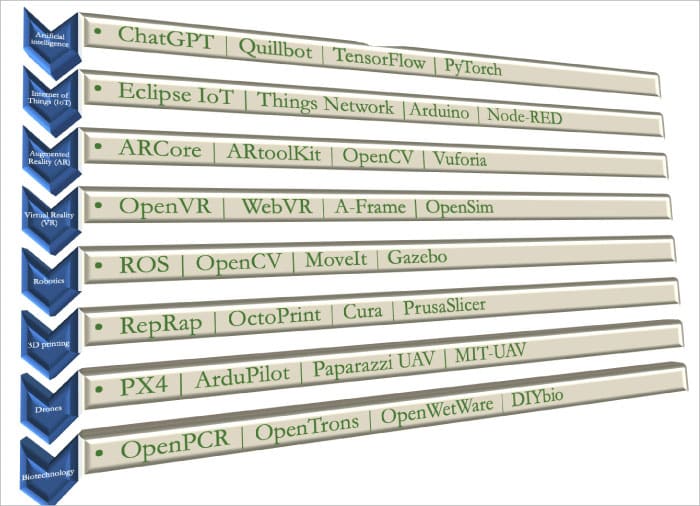Here’s a brief overview of the emerging technologies and trends in the field of IT. What’s interesting is that these are backed by some highly innovative open source software.
A lot has changed in these past three years, and technology is no different. The hybrid workforce is already a well-adopted model that has been embraced across the globe since the pandemic. The digital workplace that many tech-savvy IT leaders were pushing for has come into fruition during the last three years organically. This change has forced unified endpoint management using collaboration tools, taking advantage of the readily available cloud services.
A major shift happening across all types of organisations is clarity over the use of cloud services. There seems to be a unification of Software as a Service (SaaS) and the cloud at some levels, paving the path to cloud-agnostic architecture, design, and implementations. While cloud-agnostic platforms help move applications and data from one service provider to another, a lot of it has been achieved with open source technologies. It’s largely been made possible because of continued innovation leading to new IT capabilities.

Let’s look at the emerging technologies, trends, and their applications in the domain of open source.
Artificial Intelligence (AI)
AI has been around for over 50+ years, helping us navigate with GPS and perform repetitive tasks with machines. Autonomous AI has the ability to adapt and change in order to address complex problems. In recent months, much of the buzz has been about the launch of ChatGPT and Quillbot types of open source solutions that are taking the world by storm. It proves the active open source community is continuing to innovate above and beyond large enterprise technology offerings consistently. Microsoft has committed to spending US$ 10 billion in investment into ChatGPT towards commercialisation. It will be an interesting year ahead as this emerging technology shapes the world we live in.
There are other AI technologies, too, that are in focus, mainly TensorFlow and PyTorch, which are driving the development of machine learning and deep learning applications.
Internet of Things (IoT)
IoT has come a long way in interconnecting devices and appliances through the internet to collect, share, and act on the data that is generated. IoT technologies such as Eclipse IoT and The Things Network are helping to drive the development of connected devices and systems. Arduino is a firmware platform catering to the needs of DIY projects. Node-RED is a visual programming tool that is useful for creating workflows for IoT applications.
Augmented reality (AR)
AR focuses on overlaying digital information of the real world on the user’s view. It found its way into game development initially, and has today spread across various industries and use cases. ARToolKit and ARCore are libraries for building AR applications on Windows, Linux, and iOS. Its ability to track and overlay digital content on real-world objects has been emerging into many everyday use cases in airports, shopping malls, and other venues. OpenCV and Vuforia are platforms that provide a wide range of image processing and object recognition abilities.
Virtual reality (VR)
VR supports the creation of a computer-generated, multi-dimensional interactive environment with the help of special equipment like a VR headset. Many commercial attempts have failed to capitalise on this technology — from Google to Apple to recent Meta platforms. However, the open source community is thriving and developing new innovative ways in which it can be used. OpenVR and WebBR are at the forefront of driving the development of VR applications. A-Frame has become the popular framework for building AR-integrated VR experiences using HTML, CSS, and JavaScript; it’s built on WebGL. OpenSim is a multi-platform for 3D simulation and visualisation allowing users to create their own virtual worlds; it supports Oculus and Vive.
Robotics
Robotics aims to create intelligent machines that can assist us in various ways. With Intrinsic acquiring ROS (Robot Operating System), a popular open source platform that drives the development of autonomous robots and systems, one can hope for the best year ahead with new innovative solutions coming to support the open source community. OpenCV is another similar platform for robotics development with a rich vision library that can be used to detect and track objects, faces and more. Gazebo is simulation software that allows the simulation and testing of robot software in a realistic environment. MoveIt is popular in motion planning capabilities for various robotic arms and mobile bases.
3D printing
3D printing has advanced beyond the manufacturing industry. RepRap and OctoPrint lead the development of 3D printing applications. Cura and PrusaSlicer are slicing software developed with rich features for handling 3D printers.
Drones
Drones are flying robots that can be remotely controlled or fly autonomously using software-controlled flight plans with onboard sensors and GPS. PX4 and ArduPilot are popular platforms for the development of autonomous drones. Paparazzi UAV is an autopilot system for fixed-wing and multi-copter drones used for DIY and model development purposes. MIT-UAV is research-grade technology used in complex autonomous aircraft use cases.
Biotechnology
Biotechnology addresses the medical, agricultural, industrial, food, and marine industries in one broad stroke. Genetics engineering has been its focus area, and helped to develop the first drug for overcoming the Corona virus. OpenPCR and OpenTrons are popular development tools used for biological and medical applications. OpenWetWare is a platform that allows sharing of protocols, data, and information about research projects. DIYbio exposes citizens to biology projects, and is a promising and innovative open source platform.
As the year unfolds, one thing is certain: technology is going to play a major role in every facet of our lives and innovation is going to continue making everyday life easier. Talent shortage is one of the top concerns IT leaders are faced with when adopting emerging technologies. However, open source platforms thrive better than others, and help groom next-generation talent.















































































